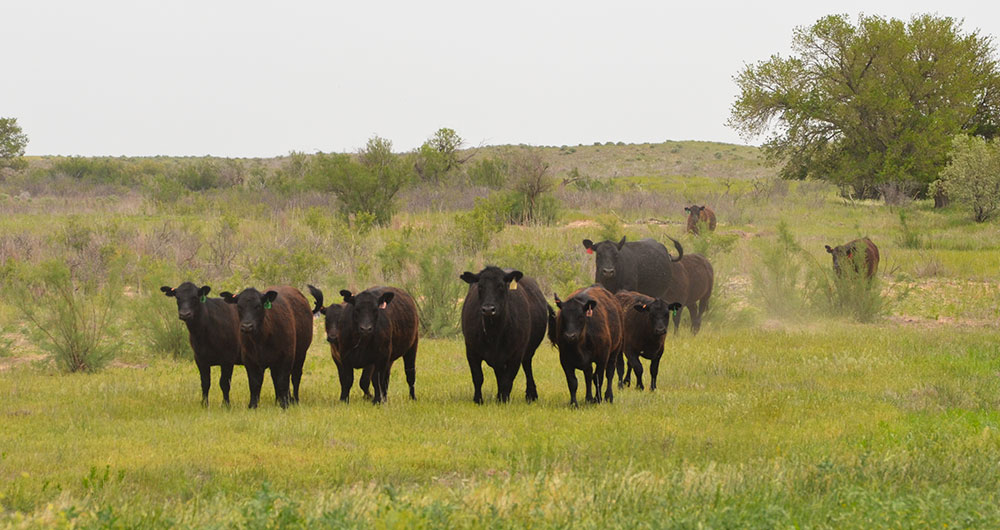
Spring Health Strategies to Turn Up Performance in Calves
Keeping calves alive and cows rebred are two main goals.
by Kevin Hill, Merck Animal Health
For cattle producers, a successful cow-calf program starts in the spring. That’s critically important this year, given the harsh winter that cattle across the country faced. From extreme cold to endless snow and record flooding, cows and calves are emerging from a very stressful season.
Among the many important management decisions producers need to consider are strategies to keep calves alive and healthy until weaning, and getting cows rebred. These will significantly affect fall profits on calves and be the start to next year’s calf crop. Thankfully, there are several strategies producers can implement to help cows thrive through breeding and gestation, and to help calves maximize their growth potential to pay dividends as they transition to the feedlot. These strategies include:
1) Build a herd health protocol
Your veterinarian can play an important role in helping you identify the pathogens and disease challenges that have the most significant effect in your area. Work with them to build a health protocol specific to the animals in your herd. They will provide sound recommendations on cow vaccinations to optimize conception and prevent abortion. In calves, the primary herd health protocols should focus on prevention of respiratory disease. As part of your herd health protocol, bulls should also be vaccinated and tested for trichomoniasis.
2) Implant calves for increased weight gain
To increase weaning weights by 20 to 25 pounds (lb.) per calf, producers should consider implanting calves. For an investment of approximately $1.50 per head, implants result in a $30 to $40 increase in calf value in today’s market.1 During the last 50 years, implants have been used in cow-calf herds to yield higher weaning weights. In these five decades since introduction in the marketplace, producers have benefited from implanting ease, flexibility and consistent results on their operations. A withdrawal period has not been established for some products in preruminating calves. Do not use in calves to be processed for veal. For complete information, refer to product labels.
3) Vaccinate cows for breeding success
In order to achieve maximum reproductive protection, producers should vaccinate cows five to eight weeks before rebreeding. This helps protect against viral and bacterial pathogens that can reduce fertility or trigger abortions. Combination vaccines achieve the necessary protection in one dose.
4) Vaccinate calves to combat viral and bacterial diseases
Protecting calves against respiratory diseases is essential for a successful fall marketing program. Both viruses and bacterial diseases can significantly affect calf performance. The biggest concerns are infectious bovine rhinotracheitis (IBR), bovine viral diarrhea (BVD), bovine respiratory syncytial virus (BRSV), and pneumonia caused by Mannheimia haemolytica or Pasteurella multocida. By properly vaccinating in the spring, calves are ready to respond rapidly to weaning vaccines.
5) Use intranasal vaccines in calves to maximize immune response
Intranasal vaccines promote a strong immune response directly on mucosal surfaces in the nasal passages — the portal of entry for respiratory infection in cattle. There are several effective intranasal vaccines that increase protection against pneumonia, avoid interference from maternal antibodies in colostrum that can block injectable vaccines and are less stressful on calves compared to similar injectable vaccinations. Another intranasal vaccine can reduce scours in newborn calves.
6) Eliminate internal parasites for increased performance2
Prior to turnout, cattle should be effectively dewormed to help eliminate parasites and keep animals performing their best. This will keep cows eating more, milking better and ultimately produce a heavier calf. Research shows that a deworming program using fenbendazole will consistently reduce fecal egg counts by more than 90%.3 When used in combination with an ivermectin product, producers achieve near 100% efficacy and help to avoid parasite resistance. Work with your veterinarian for the diagnosis, treatment and control of internal parasites.
7) Control pinkeye to keep cattle healthy
Pinkeye causes significant health challenges in cattle across the country, but it can be controlled through on-farm fly-control management and a vaccine that induces protection against bacterial infections of the eye. In areas with heavy fly pressure, fly tags in cows and calves can also provide significant protection from corneal damage due to flies.4
Not only will implementing these turnout strategies mean healthier cattle through the summer, but they will also result in added value when marketing calves in the fall. Providing buyers with a signed certificate, especially one verified by your veterinarian, documenting the health history of your calves will result in a premium paid by buyers of $15 to $35 per head.5 This documentation should include products and practices used, including vaccinations, parasite control and other treatments, and application dates.
Editor’s note: Kevin Hill is a technical service manager for Merck Animal Health. Photo by Kasey Brown.
1Selk, G. (1997) Implants for Suckling Steer and Heifer Calves and Potential Replacement Heifers. Proceedings: Impact of Implants on Performance and Carcass Value of Beef Cattle. Oklahoma State University, P-957. Pg 40.4. Superior Livestock Sale data report 2018.
2Data on file. Merck Animal Health summary of 11 studies in cow-calf herds.
3Yazwinski, T. A., Tucker, C. A., Powell, J., Jones, L. and Wray, E. Considerations for control of helminths in stocker cattle. The Bovine Practitioner, Vol. 47, No. 2.
4Derouen, S. M., Foil, L. D., Knox, J. W. and Turpin, J. M. Horn fly (diptera: muscidae) control and weight gains of yearling beef cattle. Journal of Economic Entomology. Vol. 88, Issue 3; pp. 666-668.
5Superior Livestock Sale data report 2018.























